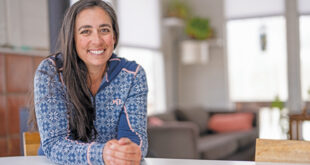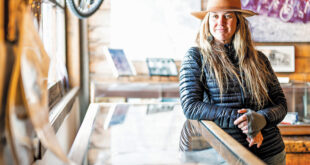For What It’s Worth
Linda Mladenka’s influences fall somewhere between post-World War Two and the Vietnam War era, peppered with an acute awareness of civil rights issues that manifested not in marches and protests, but in her daily life, where she successfully made a difference as a teacher.
Her maternal Italian grandparents got off the boat in the mid-1800s in the unlikely port of Galveston, Texas, because, Linda explains, her family had heard the climate was similar to Napoli for growing grapes. “So that’s why I’m a Texan,” Linda laughs, waving her slender hands in gesture like a true Italian.
“My mother’s surname was Battaglia,” Linda says of the name that translates literally as “battle.” The family immediately moved to Corpus Christi upon landing and she was raised in a family of Texas Democrats, which, in the 1940s, wasn’t such an oddity, she notes, Somewhat puzzled, she adds, “But my mother married a Republican.”
Her father was a WWII Navy pilot instructor and officer. Linda was born in the Panama Canal Zone before the family moved back to Texas with her brother and her and a pet spider monkey named Lucky. “Mom would walk down the streets of Corpus Christi holding me and holding the monkey’s hand,” she said of the days when primates were popular pets for service families returning from the tropics.
She started her education at Little Flower Catholic School in Norfolk, Va., where her dad was stationed, but they moved around the East Coast from Maryland to New Jersey. The eastern seaboard affected her formative years the most.
By seventh grade, the family moved to Houston and Linda distinctly remembers, “That’s where I started becoming aware of prejudice. I was bewildered. I didn’t understand racism or the things people would say about people of color.”
It was a different time, another age, when segregation was still the dirty little norm. Linda’s conviction was founded in solid reason and compassion. “I knew black people were loving families, took good care of their children, and they were god-fearing, hard workers. I didn’t understand why people would say things about them that were so hateful and unnecessary,” Linda says.
She relays one of her most defining moments as a young teen. “One of my most traumatic experiences was when I was 15 and in high school. My mother took my sister and me into this little dress shop and she was trying on clothes when a black woman walked in with her daughter. The woman picked up a dress and took it to the saleslady and asked politely if she could try the dress on. The saleswoman said, ‘No, we don’t want your kind soiling our dresses. You can buy it but you can’t bring it back.’ So the woman just held her head up high and walked out of the store,” Linda says, still moved by the memory.
“My mother grabbed our hands and we left when the black lady left. I was hurt and so embarrassed for that black woman because I was taught that a person’s face is their being and in my mind, that saleswoman had slapped that woman in the face. Right then and there, it fortified my anti-racism beliefs.”
After high school graduation in 1965, Linda enrolled in Sam Houston State College in Huntsville, which she refers to, tongue-in-cheek, as, “The other prison” (there’s also Huntsville State Prison in the same town).
“College was fun, and I was in Zeta Tau Alpha. During all this time, the civil rights movement was gaining strength and one sorority sister asked, ‘What are we gonna do if a colored girl goes through rush?’ and I said, ‘Well, we’re gonna check her grades like we do everybody else’… and there was dead silence,” Linda recalls.
She notes time of civil unrest was often referred to as “The Late Great ‘68” and the generation’s movement left its mark on her.
“Martin Luther King was killed April 4, 1968 and two months later Robert Kennedy was assassinated,” she says, pointing out that Chicago and Detroit had been under siege with riots.
“These were the things that made me think, and I would listen to that Buffalo Springfield song For What It’s Worth over and over. And that was the year I became totally convinced that I was living in the wrong state,” she laughs.
Although her heart was more inclined to pursue interior design, she graduated in 1969 with a bachelor of science degree in elementary education and set off for Houston to teach working-class kids.
“I loved those children beyond belief but I couldn’t deal with their parents. There was more racism, no empathy for anyone else, no compassion, no understanding,” Linda says, but, “Their words could never, never influence me.” After a year she moved on to southwest Houston where, she says, “At least the people there understood that you needed to keep a little bit of a tighter lip, so I didn’t have to listen to it.”
Linda met her husband-to-be, Ken Mladenka, in 1971. He had recently returned from the atrocities of Vietnam. “We got married within four months. I was so in love with his mind. I had never met anyone like him. I had finally met this man whose attitudes were so much like mine.” Ken had a master’s degree in political science and went on to Rice University for his Ph.D. in poli-sci, while Linda taught first grade.
By 1974, the couple moved to Charlottesville, where Ken was offered a professorship at the University of Virginia at Charlottesville and Linda was teaching a combined first- and second-grade elementary school class.
None of her class could read or even knew the alphabet. “It was both the best and the roughest year for me. These kids were mountain folk of Virginia who had moved into the town of Charlottesville, and black kids from poor neighborhoods.”
Because the children’s families were vying for the same economic opportunities, they didn’t like each other. “That was my first lesson in economics… that economics can cause prejudices. I was not going to let them leave my classroom without learning how to read and without learning to appreciate each other,” Lind says.
For Linda, it was her most rewarding year of teaching ever. She says, “They saw I loved each one of them equally… and they loved me. I think that for the first time in their lives they were able to let go of some of what they learned about color.”
In 1976, she gave birth to her daughter, Brooke, and the following year the new family moved to Chicago so Ken could take a visiting professorship at Northwestern for a year, until a position opened at Texas A&M and they found themselves back in the Lone Star State. Their second daughter, Lauren, was born there in 1982 and Linda stayed home after that to be a full-time mom.
Every summer the family escaped the Texas heat and headed to Crested Butte, where Linda’s sister had a condo. “Each time our visits got longer and longer until 1993 when we stayed the whole summer,” she smiles—but what really hit home and changed their course was one day back in Texas when they overheard their kids and friends outside playing and the main conversation concerned who had the biggest pool.
Disturbed by this obvious materialism, Linda said to Ken, “’We need to leave.’ We wanted to teach them a totally different way of life, and that it’s not the material things that are going to sustain you. We wanted them to meet with people who saw things differently. We suspected that Crested Butte was open-minded.” They embarked on their new adventure in living in 1994.
When they arrived in Crested Butte’s dusty August, there was nothing available to rent. “We were driving around and we passed the house at 219 Sopris, where Tom Gifford was painting and remodeling, and I asked if the house was for rent. Tom said it might be.” At that point she immediately dragged both her girls out of the car and stood them there, pleading, “’Look, we’re a family.’ He called back that night to say we had gotten the house. We’re still there.”
She skied all that winter, and worked at Traditions gift store while Ken wrote textbooks.
Back when she was deciding what to study in college, Linda’s father told her to forget interior design, but it’s really what she always wanted to do. “When I was a teen and I was first able to drive around, my girlfriends wanted to go shopping, but I wanted to go to the furniture store and the home accents store and look around. It would take my breath away. So when I got to Crested Butte, I decided to open a store. I had no retail experience at all,” this very stylish woman laughs.
Her shop, “At Home in Crested Butte” was originally named “Whimsical Mountain.” The shop is in the same location as when it first opened in the summer of 1995, in the garden level of Somrak Plaza at 319 Elk Avenue.
Almost 20 years later Linda feels, “I’ve never worked so hard for so little and been so happy.” Although she misses teaching terribly, she says, “I love what I do. I have made so many friends from around the country who come into the store.”
Linda says that after 28 years, “Ken and I grew apart but he’s still my dear friend and the father of my children.” They went their separate ways in 2000. As for skiing, she confesses, “My bones are not what they used to be. I don’t ski anymore.” But that’s never been ultimately why she’s here in this valley, and she clarifies, “It’s because of the beauty, the calmness, and the peace, the way I see how people in this community love each other and the tolerance and utter respect for each other… and besides, why would I leave heaven?”
 The Crested Butte News Serving the Gunnison Valley since 1999
The Crested Butte News Serving the Gunnison Valley since 1999




